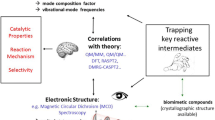Abstract
Quantum chemical modeling of Fe(III), Fe(II), and Fe(I) aqua-, aqua-hydroxo-, and aquadihydroxocomplexes is presented. The mechanism of a consecutive transfer of two electrons is studied as these forms are electrochemically reduced from an aqueous solution. The reorganization energy of the solvent and the inner sphere of studied reagents is calculated, standard redox potentials are estimated. Based on Marcus theory, the activation energy of two steps of Fe(III) reduction is estimated and the second electron transfer is shown to be rate controlling, while the energy barrier is increased due to the products of Fe(III) hydrolysis. The model predictions are in qualitative agreement with previously reported experimental data.
Similar content being viewed by others
References
F. I. Danilov, V. S. Protsenko, and A. V. Ubiikon′. Russ. J. Electrochem., 2005, 41(12), 1282.
S. Perez-Villar and J. Carretero-Gonzalez. RSC Advances, 2014, 4, 59862.
D. Pilone and G. H. Kelsall. Electrochim. Acta, 2006, 51, 3802.
J. J. O′M. Bockris, D. Drazic, and A. R. Despic. Electrochim. Acta, 1961, 4, 325.
J. T. Hupp and M. J. Weaver. Inorg. Chem., 1983, 22, 2557.
W. Li, T. Cochell, and A. Manthiram. Sci. Rep., 2013, 3, Article № 1229.
A. F. Dresvyannikov and M. E. Kolpakov. Russ. J. Phys. Chem., 2003, 77(5), 717.
A. F. Dresvyannikov, M. E. Kolpakov, and Ya. V. Ivshin, O.A. Lapina. Prot. Met., 2005, 41(6), 597.
R. L. Martin, P. J. Hay, and L. R. Pratt. J. Phys. Chem. A, 1998, 102, 3565.
D. Kochand and S. Manzhos. MRS Commun., 2018, 8, 1139.
R. Åkesson, L. G. M. Peterson, M. Sandström, and O. Wahlgren. J. Amer. Chem. Soc., 1994, 116, 8705.
M. Uudsemaa and T. Tamm. J. Phys. Chem. A, 2003, 107, 9997.
A. Bouzid and A. Pasquarello. J. Chem. Theory Comput., 2017, 13, 1769–1777.
M. A. Caro, O. Lopez-Acevedo, and T. Laurila. J. Chem. Theory Comput., 2017, 13, 3432.
D. A. Rose and I. Benjamin. J. Chem. Phys., 1994, 100, 3545.
B. B. Smith and J. W. Halley. J. Chem. Phys., 1994, 101, 10915.
R. R. Nazmutdinov, W. Schmickler, and A. M. Kuznetsov. Chem. Phys., 2005. 109, 257.
R. R. Nazmutdinov, T. T. Zinkicheva, G. A. Tsirlina, and Z. A. Kuz′minova. Electrochim. Acta, 2005, 50, 4888.
M. J. Frisch, G. W. Trucks, H. B. Schlegel et al. Gaussian 09, Revision B.01. Gaussian, Inc., Wallingford CT, 2009.
J. P. Perdew, K. Burke, and V. Ernzerhof. Phys. Rev. Lett., 1966, 77, 3865.
M. Radoń, K. Gąssowska, J. Szklarzewicz, and E. Broclawik. J. Chem. Theory Comput., 2016, 12, 1592.
Chemcraft–Graphical Software for Visualization of Quantum Chemistry Computations. https://www.chemcraftprog.com
S. Amira, D. SpÅngberg, M. Probst, and K. Hermansson. J. Phys. Chem. B, 2004, 108, 496.
S. Amira, D. SpÅngberg, V. Zelin, M. Probst, and K. Hermansson. J. Phys. Chem. B, 2005, 109, 14235.
B. S. Brunschwig, C. Creutz, D. H. Macartney, T.-K. Sham, and N. Sutin. Faraday Discuss. Chem. Soc., 1982, 74, 113.
R. A. Marcus. J. Chem. Phys., 1965, 43, 679.
CRC Handbook of Chemistry and Physics / Ed. D. R. Lide, 2005.
S. Remita, P. Archirel, Faraday Discuss M. Mostafi. J. Phys. Chem., 1995, 99, 13198.
R. R. Nazmutdinov. Rus. J. Electrochem., 2002, 38, 131.
L. A. Curtiss, J. W. Halley, J. Hauptman, N. C. Hung, Z. Nagy, Y.-J. Rhee, and R. M. Yonko. J. Electrochem. Soc., 1991, 138, 2032.
Funding
This work was supported by the Russian Science Foundation (project No. 17-13-01274).
Author information
Authors and Affiliations
Corresponding authors
Additional information
Conflict of Interests
The authors declare that they have no conflict of interests.
Russian Text © The Author(s), 2019, published in Zhurnal Strukturnoi Khimii, 2019, Vol. 60, No. 8, pp. 1280–1287.
Rights and permissions
About this article
Cite this article
Nazmutdinov, R.R., Zinkicheva, T.T., Kolpakov, M.E. et al. Quantum Chemical Modeling of Electrochemical Consecutive Reduction of Fe(III) Aqua- and Aqua-Hydroxocomplexes. J Struct Chem 60, 1226–1233 (2019). https://doi.org/10.1134/S0022476619080031
Received:
Revised:
Accepted:
Published:
Issue Date:
DOI: https://doi.org/10.1134/S0022476619080031




